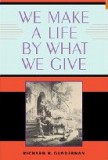We Make a Life by What We Give

|
Title | We Make a Life by What We Give |
| Author | Richard B. Gunderman | |
| Reviewer | Heather Wood Ion | |
| Review Date | August 03, 2009 | |
| Publisher | Bloomington, Indiana: Indiana University Press | |
| Year | 2008 | |
| Rate this Book |
Some books enlighten us, some books inspire us, and some books challenge us to expand our understanding of who we are and who we can become. Richard Gunderman’s We Make a Life by What We Give does all three.
Dr. Gunderman addresses the issues of philanthropy and the roles of generosity in our lives with stunning clarity, and with a broad courage asks the wicked and necessary questions that many authors avoid. He begins by distinguishing between our various models of philanthropy: the charity model which often creates both dependency and resentment; the model of scientific giving which deepens the distinctions between givers and recipients; and the liberal model which enhances the flourishing of the giver as well as the recipient.
From the first chapter onward, the questions raised are critical to our understanding of what the volunteer sector does and can do in our society. These questions are elegant but challenging, “Are the things that are easiest to quantify also the ones we most need to know?” (4) and they should be points of discussion for everyone willing to examine what they do and how they do it.
The highest aim of philanthropy, says Gunderman, is to be transformational and inspirational (28). That in itself is a challenge to workers in the nonprofit sector, let alone professionals in philanthropy. In Chapter 6 “Egoism, Altruism and Service” a thoughtful exploration of motivation clarifies why Gunderman feels many people are bored with giving money, and why philanthropy must not be mere advocacy of special interest groups, but service to the future (52, 68).
There is a fascinating section in Chapter 11 “Materialist Philanthropy” which outlines the particularity of the gift and critiques the divisiveness of conspicuous giving (103). On page 135, Gunderman clearly challenges the entire sector by asking, “What is the bottom line of a philanthropic organization?” Is it dollars raised? Is it dollars disbursed? Is it outcomes achieved? The plethora of volunteer and nonprofit groups in this country needs to wrestle with these questions in order to rise to serving a purpose greater than survival.
A theme through this engaging book which warrants far more attention across all disciplines is the role of imagination in our generosity. Gunderman manages the impossible by showing us applications of curiosity, of hope, of love, and of suffering to more generous and purposeful living. Chapter 18 “Are we Hospitable?” grounds the theoretical discussion in a practical and pragmatic reflection on generosity within a hospital, and how caring and healing depend both on imagination and curiosity. This chapter alone can contribute a new worldview to our healthcare industry.
Richard Gunderman is erudite, but he wears his scholarship gracefully, elucidating Aristotle or Homer or the Bible with engaging simplicity. He is equally at home explaining a film, like Black Hawk Down, in terms of the themes of altruism, generosity and suffering. Not only does he himself see the world with a new vision, but he enables us to view ourselves and our particular worlds with that same vision, which for any author is a stunning achievement.
As I came to the end of the book I felt I had been served a banquet of wisdom, and shared that banquet with a most charming host, but I also felt a sad concern that this book will not reach the mass audience it deserves. This is a clarion call for better philanthropy, for wiser living, for more curious and imaginative engagement. The book should not be confined to its label—philanthropic and nonprofit studies—but read by all those seeking to lead a more meaningful life within communities and organizations which cultivate human flourishing. I would like to see the book in the hands of every teacher, every person who is employed by or volunteers within a social service entity, every faith-based organization seeking relevance to our common good.
Near the end of the book Gunderman writes, “our understanding of generosity reflects our understanding of the world we inhabit” (191). We Make a Life by What We Give reflects the compassion, wisdom and inspiration in which we will find the angels of our better nature. It simply surpasses all other books in the field, but more importantly, it expands our understanding of the field of philanthropy and of ourselves and our potential.
Heather Wood Ion is a cultural anthropologist, currently with Athena Charitable Trust, and a contributing editor to Conversations on Philanthropy.



